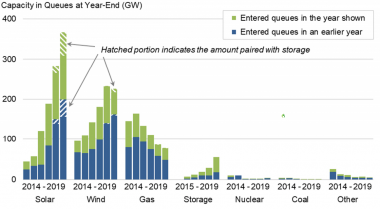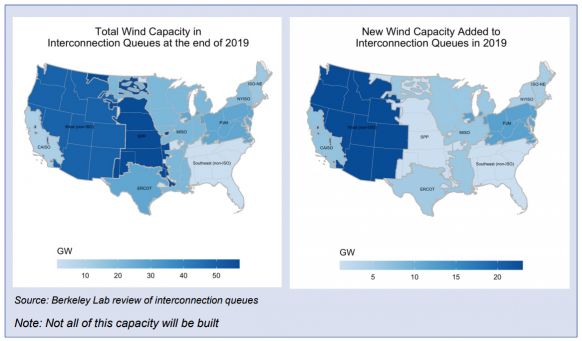As Texas probes power grid, national failings bite
The US must overhaul payment models for grid upgrades and impose greater federal oversight of interstate transmission projects to curb delays to wind and solar projects, policy experts said.

Related Articles
The Texas power crisis highlights the dangers of inadequate transmission capacity and comes as the US grapples with a growing national infrastructure challenge.
President Biden's pledge to decarbonise the power sector by 2035 requires a massive buildout of wind and solar capacity and grid investments are lagging far behind.
“The Texas experience will certainly help focus attention on the need for better, more integrated infrastructure,” Jay Caspary, Vice President of consulting firm Grid Strategies, told Reuters Events.
“Neighbouring states had power available, but there wasn’t the means to deliver it into Texas,” he said.
A lack of interstate transmission build and costly grid connection procedures is delaying US wind development, Ryan Wiser, Senior Scientist, Lawrence Berkeley National Laboratory, said.
“Wind development is beginning to hit real roadblocks. In part, this is because the era of large, interregional transmission builds has been on hold for some years now,” he said.
“In addition, the transmission interconnection queues are clogged with projects that are having a tough time getting through the process with reasonable interconnection costs,” Wiser added. “There are challenges in [the Midcontinent Independent System Operator], in [the Southwest Power Pool], in the West, in the Northeast, and elsewhere.”
US generation capacity in interconnection queues
(Click image to enlarge)
Source: Lawrence Berkeley National Laboratory (Berkeley Lab), August 2020
The US needs to reform planning, permitting and payment rules for grid infrastructure as multi-state projects are hampered by different state requirements and timelines, Liza Reed, Research Manager for Low Carbon Technology Policy at the Niskanen Center think tank, said.
“The federal government has only a limited role in transmission siting, but that could be changed,” Reed said. “Transmission investments are primarily seen at the local level, which means that sharing of resources, like wind and solar from the great plains and southwest, just isn't happening.”
Developer pays
In January, the Biden Administration issued Executive Orders to federal agencies to "accelerate clean energy and transmission projects under federal siting and permitting processes."
The US system for planning and paying for transmission grid is causing a massive backlog and delay in the construction of new power projects, according to a recent report from Americans for a Clean Energy Grid (ACEG).
Around 245 clean energy projects that had reached advanced stages of development were halted between January 2016 and July 2020, the Natural Resources Defense Council, a non-profit international environmental advocacy group, said in a separate report. Grid congestion and grid upgrade costs were cited as some of the main factors, it said.
Currently, developers are required to pay for upgrades to transmission lines if they want to develop a project. Portugal's EDP Renewables withdrew from a planned 100 MW project in Minnesota because grid updates would have cost close to $80 million, according to reports.
"Developers are charged with paying for transmission upgrades despite the fact that there are broad-based, regional benefits,” ACEG said in its report.
US wind capacity in interconnection queues by market
(Click image to enlarge)
Source: Lawrence Berkeley National Laboratory (Berkeley Lab), August 2020
The US would need to spend around $700 billion on 200,000 miles of transmission lines to achieve 100% power generation from renewable energy, Wood Mackenzie said in a report in 2019.
FERC and other planning authorities should scrap the policy of developer payments and implement an up-front planning system that expands regional and interregional transmission planning and spreads the cost to all beneficiaries, ACEG said.
Another option would be for the federal government to offer tax credits for the required grid upgrades and developments, Reed said.
Interstate gap
A notable lack of grid spending in the last five years is hampering wind and solar development, Sam Brock, spokesman for the American Clean Power Association, said.
“Moreover, most of the spending during this recent period has been on smaller reliability projects and not on the backbone larger ventures," he added.
Interstate projects have been particularly difficult to complete, as they require siting approvals from state and local authorities, Brock noted.
The benefits of grid transmission have not been widely appreciated, leading some consumers, utilities, and regulators to oppose projects, he said. One example was the shelved 700-mile Plains and Eastern Clean Line that would have sent 4 GW of wind power from the Oklahoma Panhandle region to consumer markets in the Mid-South and Southeast, Brock said.
"We definitely need more federal oversight with regard to grid investments and new developments, as at the moment every state has its own rules and regulations," Reed said.
Some of the concepts that support gas pipeline buildout in the US Natural Gas Act could be applied to renewable energy infrastructure, with appropriate protection for landowners, Reed said.
A "macro grid" approach to grid investment that allows the transfer of large volumes of power from areas with high renewable resources to high demand centres would generate a wide range of economic and social benefits, the ACEG and American Council on Renewable Energy (ACORE) noted in a joint report.
A US-wide grid plan would "deliver job growth and economic development, a cleaner environment, and lower costs for consumers," the industry groups said.
Reporting by Ed Pearcey
Editing by Robin Sayles


